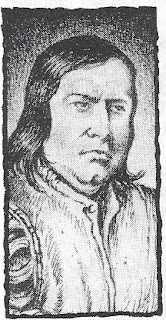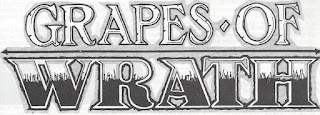Warhammer Fantasy Roleplay: Grapes of Wrath
By Carl Sargent with Derrick Norton
Published by Games Workshop
Published in White Dwarf issue 98, Grapes of Wrath was intended to serve as "a prelude to The Power Behind the Throne and continuing The Enemy Within Campaign." However, this 18 page Warhammer Fantasy Roleplay adventure could easily be played independently or as a part of your own campaign, as the writer is quick to point out.
Set in the small but prosperous village of Pritzstock, a few miles away from the city of Middenheim, the adventurers discover that the villagers are being plagued by flying skulls on the eve of their annual grape harvest. Besides the physical danger posed by the skulls, the loss of the town's sole source of income is perhaps an even greater threat. The adventurers find themselves embroiled in the mystery of the skulls, which proves to be even more complicated than it first appears.
Grapes of Wrath follows the standard format for WFRP 1st edition adventures. The players are dropped into a colorful setting with a cast of dynamic characters, all of whom have their own agendas. A sort of sandbox approach is taken. certain events will happen no matter what, though ultimately the resolution comes down to how the players approach the situation. It even opens with a carriage crash, one of the most recognizable 1E hallmarks.
Sticking to the format is hardly a bad thing, considering this is WFRP 1E. Both the players and game masters are given plenty to play with, as most events can unfold a number of different ways. Even so, there's still a looming threat to keep players on track.
In this case, it's dealing with the skulls before the harvest spoils and Pritzstock is ruined financially. A more practical and believable motive than a lot of fantasy plots.
 |
| Games Workshop |
There's plenty of ways for the player characters to get in trouble, a few of them far from the main plot. In one popular fantasy trope that doesn't make it into many RPGs, player characters can end up in a duel with the local noble if his love interest gets too involved with any of them.
Hardly an ideal situation, especially considering he's also the captain of Pritzstock's fledgling militia.It makes finding the cause of the skulls much more interesting, as it's a struggle to figure out what's even happening from such unreliable sources. While it's one of the more combat facing segments of The Enemy Within, there's still a strong mystery to unravel, with plenty of red herrings and complications.
The skulls themselves are memorable antagonists, combining a few different elements of Warhammer's background for something unique. Especially as the days drag on and the attacks grow in intensity, proving the skulls to be surprisingly dangerous foes. They're given a huge amount of detail, both in how they function and their time tables. That allows players to get creative when it comes to discovering the source.
Once there, the adventure only gets more complicated instead of turning into the typical fantasy RPG "clear out the cave" scenario. The skulls' master has a surprisingly sympathetic motivation, as he proves to be the victim of circumstance and one particular Pritzstocker's villainy. That doesn't stop him from reaching villainous ends, as the skulls' true power influences him.
It's still a nice twist that the character you'd expect to be the main antagonist is just one of several and probably not even the worst of the bunch.
 |
| Games Workshop |
In an amusing narrative parallel to sections of Death on the Reik, the Skaven barge into the scene once again. Villainous ratmen are also seeking out the skulls but for very different reasons. The adventurers can even cooperate with them, against their better judgment.
Overall, it's a scenario that taps into what makes WFRP 1E adventures so fun: Every major character has a coherent motivation, they all have agendas that will cause problems, and there's always at least one curve ball to keep things interesting.
Grapes of Wrath is a surprisingly miserable scenario, even compared to previous Enemy Within publications. The initially amusing setup, magic skulls plaguing a stuck up village, ends up being a whole lot more tragic. The scenario has a wide range of endings, depending on certain factors: did the Skaven get what they want, was the skulls' mystery properly solved, was Pritzstock saved, and was the harvest spared? The apparently best ending is on its face happy but simply means the adventurers failed to discover the injustice that caused all of this.
In my experience running the adventure, it never ends well for Pritzstock. If the town is saved, the harvest isn't. Even if all goes well on that end, the truths uncovered put a very sour note on things. For a scenario that uses established Warhammer concepts fairly abstractly, it nails the tone of the setting perfectly. I can think of few prewritten adventures where even with no hope of a "good" ending, it still feels so satisfying.
 |
| Games Workshop |
Overall, Grapes of Wrath is an excellent, overlooked adventure module. Throughout its short length, Carl Sargent and Derrick Norton crafted an excellent glimpse into the absurd but tragic lives led in the Warhammer World. There's a strong sense of humor and enthusiasm that bleeds into the text, getting game masters into the right headspace. I particularly appreciated the literary allegory to one of the more famous Edgar Allan Poe works and a brief gag about how badger-like classic Skaven look.
 |
| Games Workshop |
Even so, it's a good bottle episode to remind the players that even their world changing quest is just another story in a world full of them. Grapes of Wrath is certainly far superior to the interlude Hogshead Publishing replaced it with, Carrion on the Reik.
That's mainly because Grapes of Wrath is an adventure that gives everyone at the table agency. Players can take whatever route they wish but the rewards hinge on how creative they were. Most tellingly, the best rewards come from how often they can achieve their main goals "without a sword being drawn."
At the end of the day, having those options is what I want the most out of any adventure, prewritten or otherwise.

A story with character!
ReplyDelete